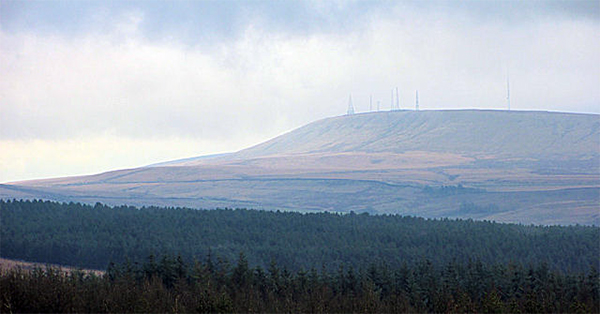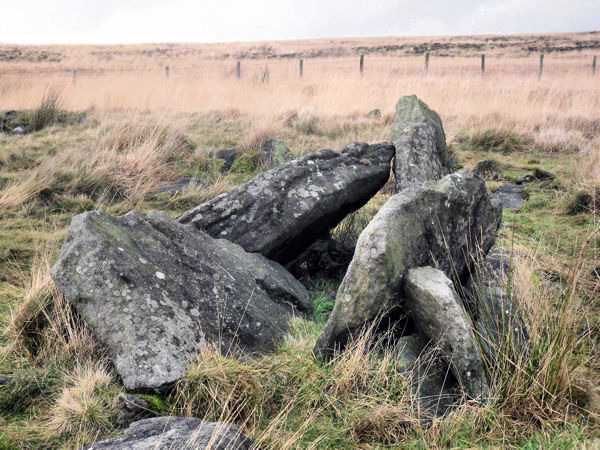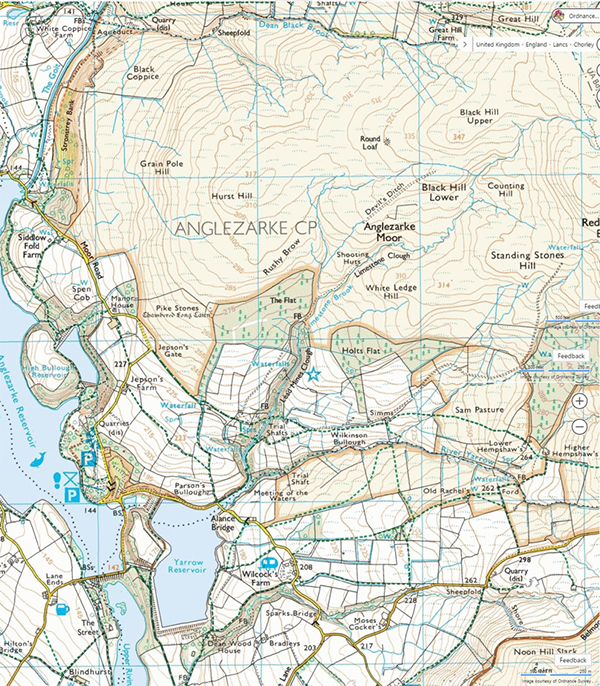
The ever-present skyline of the W. Pennine moors have always provided a mystic backdrop for anyone travelling through S.W. Lancashire. In the mid 80's, the Lancaster University Archaeology Unit (now Oxford Archaeology North) carried out extensive research, field surveys and excavations on these moors. The result was a paper published in the 'Proceedings of the Prehistoric Society' in 1996 (61, pp 133-166).
It catalogues in detail all the work that had been carried out over the years together with all the finds and results from environmental sampling. The picture it paints is of a landscape which has seen activity going back as far as the Mesolithic (8000BC) through the Neolithic to the Bronze Age (strangely though, little or no Iron Age or Roman). The Palynological (or pollen study) contribution came from Malcolm Bain who had been investigating the area for 10 years (in the 1990's Malcolm give our Society a series of lectures on the subject). The investigations by the Lancaster Unit were comprehensive, but by no means were they the first to survey and excavate on these moors. This credit goes to the Chorley Archaeological Society whose activities in the mid 1950's paved the way for much of the work that followed. In those days only two sites were known on these uplands;

Pikestones - a Neolithic chambered cairn and Round Loaf - possibly a large Bronze Age round barrow (which the Society were the first to survey). In 1957 the Society discovered a burial mound on Winter Hill which they excavated the following year overseen by Dr Bu'lock and Mr Rosser of Manchester University. Few finds turned up but in the 1980's a flint axe-head was found lying close by. Not long after the dig, John Winstanley, the Society's secretary, left to form the Bolton Archaeological Society.
That year they excavated Noon Hill, another burial mound on the Rivington Moor. This time, cremated bones were found of a man, woman and child, some of which were in an upturned Bronze Age food vessel. In 1961 Chorley Society excavated on Stronstrey Bank - a steep escarpment on the west side of Anglezarke Moor, where they found an array of flints ranging from the Mesolithic to the early Bronze Age. In 1982 the Society discovered a cairn on the western slopes of Hurst Hill not far from Pikestones. This cairn later became known as Jepson's Gate cairn and was covered at the time in peat. To prove it was man-made, peat was removed to reveal the extent of the cairn (5.3m x 3.8m) exposing a kerb around its periphery. The Society duly reported the find to the North West Water Authority, who owned the land, and waited for their requested permission to dig to be processed. In the meantime however, in the following year, due to a misunderstanding or a general lack of communication, the site was reported to the Central Lancashire Archaeology Unit (CLAU), as being under threat from severe erosion and vandalism.
The field officer for the Unit, P. Gibbons, apparently unaware of Chorley's work, recommended excavation as soon as possible. This was duly carried out later that year by the Lancaster Unit (without Chorley's knowledge). No finds were recorded except a lot of charcoal in a central pit lined with what appeared to be a badly decayed ceramic vessel. The Unit went on to excavate another site on the Moor at Rushy Brow where a scattering of microliths were recovered suggesting a Mesolithic site. Also during their survey the Unit discovered a previously unrecorded chambered cairn on the Stronstrey Bank (the area is known as Black Coppice and overlooks the village of White Coppice to the northwest). Much of the information in the report comes from John Hallam, archaeological adviser to the Central Lancs Development Corporation and founder of the CLAU. He collected and catalogued many of the flint finds from the moors, including the ones from the Chorley Society. When he died in 2009 it was a great loss to archaeological community.

December Meeting
As with the last couple of years, we've decided on a meal and quiz again for this meeting. Please let myself or Mary know if you intend going (meal menu to follow).
Next Meeting
Wednesday 1st November. - in the Standish Suite at the Brocket Arms (7.30pm as usual). This month we have our old friend Jack Smith, former chairman and founder member of the Chorley & District Archaeological Society. Jack was part of the team of field surveyors and excavators who carried out much of the work on Anglezarke and Rivington Moors. His recollection of those times is bound to make a fascinating talk. Hope to see you then - BA
|



